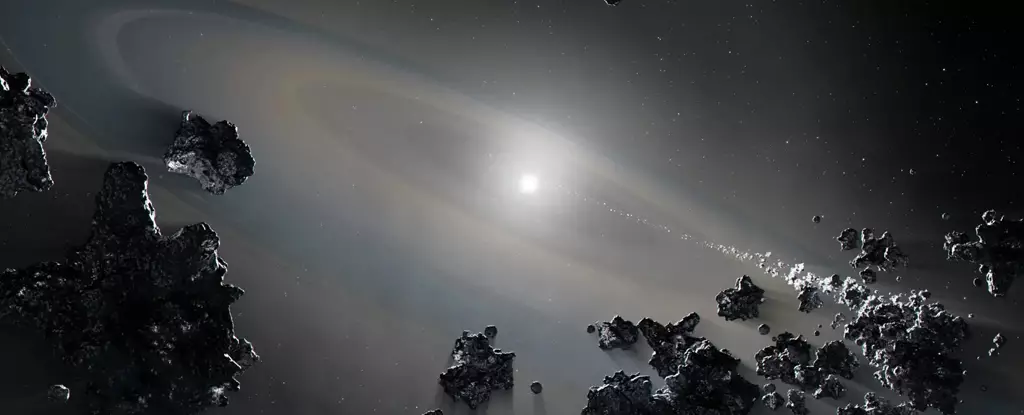Astronomers have long been captivated by the enigma of white dwarf stars. These celestial remnants, once part of larger main sequence stars like our Sun, hold secrets about the evolution of stellar systems. As a star in the same mass range as our Sun approaches the end of its life, it swells up and transforms into a red giant. Eventually, the red giant sheds its outer layers in a stunning display known as a planetary nebula. After thousands of years, all that remains is a white dwarf, a compact object resembling Earth in size but with immense density.
With their habitable zones residing in close proximity, white dwarfs have raised questions about the potential existence of terrestrial, Earth-like planets in their vicinity. While scientists have discovered numerous white dwarf stars surrounded by debris disks, remnants of planets destroyed during the star’s evolution, the presence of intact planets remains a tantalizing mystery. However, recent findings have yielded promising clues, offering a glimpse into the hidden realm of white dwarf planets.
In 2020, astrophysicists announced a groundbreaking discovery — an intact Jupiter-mass planet orbiting the white dwarf WD1054-226. This revelation challenges the prevailing belief that white dwarfs only host remnants of destroyed planets. If one intact planet exists, there is a strong possibility of others scattered across the cosmos. However, the existence of a Jupiter-mass planet raises questions about the dominant composition of the white dwarf exoplanet population. Are smaller, rocky planets rare within this celestial realm?
In a newly published paper titled “The giant nature of WD 1856 b implies that transiting rocky planets are rare around white dwarfs,” David Kipping, an Assistant Professor in the Department of Astronomy at Columbia University, explores the scarcity of rocky white dwarf planets. Despite the enduring nature of white dwarfs and their potential habitable zones, the presence of transiting rocky planets remains a puzzling rarity. The solitary intact planet discovered so far, WD 1856 b, possesses a mass approximately 13.8 times that of Jupiter. This finding defies the expected proportion between giant and terrestrial exoplanets.
When we examine the number of confirmed exoplanets, the statistics seem to contradict Kipping’s hypothesis. The NASA Exoplanet Catalogue lists 5,535 confirmed exoplanets, including 1675 terrestrial, or Earth-like, planets. However, these numbers inherently suffer from selection bias due to detection methods employed, providing only a limited view of the actual exoplanet distribution.
Kipping postulates two possible explanations to reconcile the evidence for small planets with the presence of WD 1856 b. Firstly, there may be a distribution turnover at a specific radius, representing an unlikely planetary size, leading to an underrepresentation of terrestrial planets. This highlights the inherent unpredictability of exoplanet distributions. Alternatively, WD 1856 b may simply be an anomaly, randomly detected as the first transiting planet. Consequently, drawing definitive conclusions from a single data point proves challenging and calls for more comprehensive research.
The discovery of WD 1856 b, while intriguing, does not provide an unequivocal confirmation of the rarity of terrestrial planets around white dwarfs. As scientists emphasize, the current hypothesis lacks firm conviction and necessitates further exploration. To unravel the secrets of white dwarf exoplanets, ongoing and future searches remain crucial.
The unique properties of white dwarfs present unprecedented opportunities for scientific inquiry. With their compact size comparable to Earth, white dwarfs potentially host planets of similar proportions. Detection of Earth-like planets in such systems would open up new avenues for habitability and the persistence of life in the vast expanse of the universe.
As astronomers embark on this nascent field of white dwarf exoplanet science, the stable and long-lived nature of these stellar remnants holds promise. With careful observation and focused investigations, the true population of planets around white dwarfs will gradually emerge. Through this dedicated pursuit, researchers hope to uncover the hidden worlds that inhabit the fascinating realm of white dwarf stars.
While the discovery of an intact Jupiter-mass planet orbiting a white dwarf has ignited intrigue within the scientific community, the question of how prevalent terrestrial worlds are within these systems remains uncertain. As researchers continue their quest for knowledge, expanding our understanding of white dwarf planets may offer profound insights into the cosmic tapestry of exoplanet populations and the potential for life beyond our own celestial home.



Leave a Reply